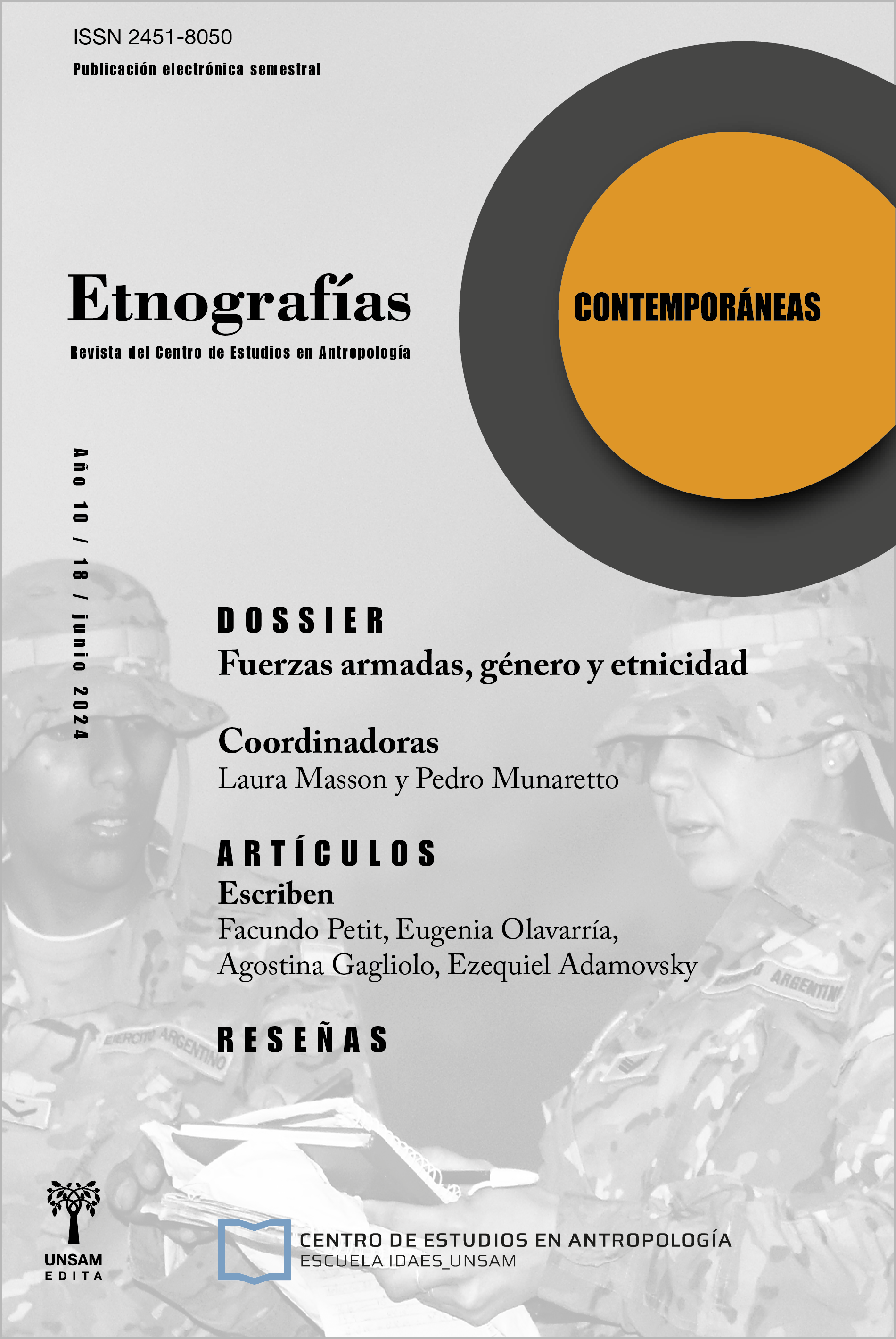Fuerzas Armadas y ciencias sociales. Vasos comunicantes con nuevos emergentes
género y etnicidad
Citas
Badaró, M. (2009). Militares o ciudadanos. La formación de los oficiales del Ejército Argentino. Prometeo.
Badaró, M. (2015). “One of the Guys”: Military Women, Paradoxical Individuality, and the Transformations of the Argentine Army. American Anthropologist, 117(1), 86-99. DOI: 10.1111/aman.12163
Castro, C. (1990). O espíritu Militar. Um antropólogo na caserna. Zahar.
–––(2007). Diversity in the Brazilian armed forces. En J. Soeters y J. Van der Meulen (Eds.), Cultural Diversity in the Armed Forces. An International Comparison (64-76). Routledge.
Castro, C. y Leirner, P. (2009). Antropologia dos militares: reflexões sobre pesquisas de campo. FGV.
Cook, C. y Winslow, D. (2007). The Role of Gender in Civil – Military Cooperation: A Unique Opportunity for Change. Peace and Conflict Studies, 14(1). DOI: 10.46743/1082-7307/2007.1078. https://nsuworks.nova.edu/pcs/ vol14/iss1/4
Dandeker, C. (1994). New times for the military: some sociological remarks on the changing role and structure of the armed forces of the advanced societies. The British Journal of Sociology, 45(4), 637-654.
Davis, K. (2020). Negotiating Gender Inclusion. En A. Edgar, R. Mangat y B. Momani (Eds.), Strengthening The Canadian Armed Forces Through Diversity And Inclusion (36-51). University of Toronto Press.
Edgar, A., Mangat, R. y Momani, B. (2020). Strengthening The Canadian Armed Forces Through Diversity And Inclusion. University of Toronto Press.
Elron, E., Shamir, B. y Ben-Ari, E. (1999). Why Don’t They Fight Each Other? Cultural Diversity and Operational Unity in Multinational Forces. Armed Forces & Society, 26(1), 73-97.
Frederic, S. (2014). Las trampas del pasado: las Fuerzas Armadas y su integración y su integración al estado democrático en Argentina. Fondo de Cultura Económica.
–––(2015). Women’s ‘Integration’ into the Argentine Armed Forces and Redefinition of Military Service. What does Military Democratization mean?. Dynamiques Internationales, 11.
–––(2017). Explicar la eficacia de una operación de paz, buscando reconocimiento como militares. La experiencia de los cascos azules argentinos en Haití. Revista del Museo de Antropología, 10(1), 117-128.
Frederic, S., Masson, L. y Soprano, G. (2015). Fuerzas Armadas en democracia. Percepciones de los militares argentinos sobre su reconocimiento. Prohistoria.
George, T. (2020). Race and Belonging. En A. Edgar, R. Mangat y B. Momani (Eds.), Strengthening The Canadian Armed Forces Through Diversity And Inclusion (114-134). University of Toronto Press.
Guber. R. (2012). .Por qué Malvinas? De la causa nacional a la guerra absurda. Fondo de Cultura Económica.
–––(2016). Experiencia de Halcón. Ni héroes ni kamikazes: pilotos de A4B. Sudamericana.
–––(2022). Los mares de la aviación naval. En R. Guber (Ed.), Mar de guerra. La Armada de la República Argentina y sus formas de habitar el Atlántico Sur en la Guerra de Malvinas, 1982 (145-190). SB.
King, A. (2013). The Combat Soldier. Infantry Tactics and Cohesion in the Twentieth and Twenty-First Centuries. Oxford University Press.
Lomsky-Feder, E. y Ben-Ari, E. (2000). The Military and Militarism in Israeli Society. SUNY Press.
–––(2012). Managing Diversity in Context: Unit Level Dynamics in the Israel Defense Forces. En Armed Forces & Society, 39(2), 193-212.
Lomsky-Feder, E. y Sasson-Levy, O. (2018). Women Soldiers and Citizenship in Israel Gendered Encounters with the State. Routledge.
Masson, L. (2017). Women in the Military in Argentina: Nationalism, Gender, and Ethnicity. Gender Panic, Gender Policy, 24, 23-43. DOI: 10.1108/S1529-212620170000024002.
Masson, L. (2020). Militares argentinas. Evaluación de políticas de género en el ámbito de la defensa. Universidad de la Defensa Nacional.
McFate, M. (2018). Military Anthropology. Soldiers, Scholars and Subjects at the Margins of Empire. Oxford University Press.
Medina González Dávila, J. (2008). La antropología militar: .aplicación o perversión de la ciencia?. En Iberoforum. Revista de Ciencias Sociales de la Universidad Iberoamericana, 3(6), 58-81.
Neiburg, F. y Goldman, M. (1998). Antropologia e política nos estudos de caráter nacional. Anuário Antropológico, 22(1), 105-138.
Price, D. (2011). Weaponizing Anthropology. AK Press y Counterpunch.
Sasson-Levy, O. (2002). Constructing Identities at the Margins: Masculinities and Citizenship in the Israeli Army. Sociological Quarterly, 43(3), 357-383.
–––(2003a). Feminism and Military Gender Practices: Israeli Women Soldiers in “Masculine” Roles. Sociological Inquiry, 73(3), 440-465.
–––(2003b). Military, masculinity, and citizenship: Tensions and contradictions in the experience of blue-collar soldiers. Identities, 10(3), 319-345.
–––(2007). Contradictory Consequences of Mandatory Conscription The Case of Women Secretaries in the Israeli Military. Gender & Society, 21(4), 481-507.
Selmeski, B. (2007). Indigenous integration into the Bolivian and Ecuadorean armed forces. En J. Soeters y J. Van der Meulen (Eds.), Cultural Diversity in the Armed Forces. An International Comparison (48-63). Routledge.
Shamir, B. y Ben-Ari, E. (2000). Challenges of Military Leadership in Changing Armies. Journal of Political & Military Sociology, 28(1), 43-59.
Soeters, J. y Van der Meulen, J. (2007). Cultural Diversity in the Armed Forces. An International Comparison. Routledge.
Soprano, G. (2013) Ser militar en la Argentina del siglo XXI: entre una vocación, una profesión y una ocupación. Avá, 23, 71-95.
–––(2023). Claves para un análisis del combate en el nivel táctico en la Guerra de Malvinas. Un estudio de experiencias de oficiales de una Promoción del Ejército Argentino. En Prohistoria, 26(39), 1-37.
Tomforde, M. y Ben-Ari, E. (2021). Anthropology of the Military. En A.M. Sookermany (Ed.), Handbook of Military Sciences. [En línea]. DOI: 10.1007/978-3-030-02866-4_82-1
Woodward, R. y Winter, P. (2006). Gender and the Limits to Diversity in the Contemporary British Army. Gender, Work and Organization, 13(1), 45-67.
























